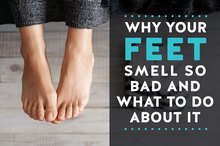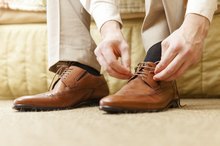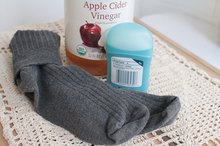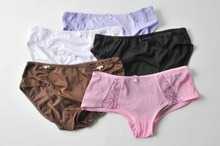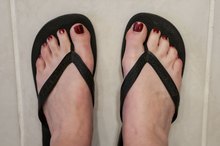What does fact checked mean?
At Healthfully, we strive to deliver objective content that is accurate and up-to-date. Our team periodically reviews articles in order to ensure content quality. The sources cited below consist of evidence from peer-reviewed journals, prominent medical organizations, academic associations, and government data.
The information contained on this site is for informational purposes only, and should not be used as a substitute for the advice of a professional health care provider. Please check with the appropriate physician regarding health questions and concerns. Although we strive to deliver accurate and up-to-date information, no guarantee to that effect is made.
Sweaty feet don't play favorites. Your two feet have about 250,000 sweat glands between them, which typically produce up to half a pint of moisture per day.
That means you can find yourself with soaked-through socks or even shoes in the gym, at work or on a strenuous walk or hike. Fortunately, for most people, a few simple choices can keep you from having to "squish-squish" your way through every step of your day.
Read more about home remedy for sweating feet.
Breathable Footwear as "Sweat Shoes"
Waterproof, breathable shoes may be all the rage for running, hiking and everyday casual wear, but they're the absolute worst choice if you know your feet tend to be sweaty. That's because the same waterproof/breathable membrane that does such a good job of keeping rain, snow and mud out of your shoes is also good at keeping your sweat in 4.
Just to add insult to injury, once waterproof shoes get wet for any reason — whether it's from sweat, rain or anything else — that relative impermeability means they take longer to dry than any other type of footwear.
Happily, the solution is an easy one: Most manufacturers that produce waterproof shoes also offer non-waterproofed, highly breathable versions of the same shoe models. Even if you weren't wearing waterproof shoes to begin with, switching to a more breathable shoe with mesh panels in the uppers can help you keep your feet dry 4.
You can even find breathable dress shoes with some careful searching. And if you were wearing waterproof shoes because of wet conditions on the way to work, all you have to do is keep a pair of breathable work shoes under your desk and change once you make it there; that also creates an opportunity for your outdoor shoes or boots to dry out before you head home 4.
- Waterproof, breathable shoes may be all the rage for running, hiking and everyday casual wear, but they're the absolute worst choice if you know your feet tend to be sweaty.
- Even if you weren't wearing waterproof shoes to begin with, switching to a more breathable shoe with mesh panels in the uppers can help you keep your feet dry 4.
Closed Toes Are Important for the Gym
Why Your Feet Smell So Bad — And What to Do About It
Learn More
If you're strolling in a casual environment, you might even be able to get away with wearing sandals to give your feet as much ventilation as possible.
But if you're looking for shoes you can wear at the gym, sandals are a big no-go, and most gyms will kick you out if you try to wear them on the gym floor. That's because closed-toed shoes are your best protection against a myriad of risks to your 10 little piggies, from flying dumbbells and weight plates to all the moving, pinching parts in a treadmill or elliptical trainer.
What About Your Socks?
Your choice of socks matters too. If you're wearing wool socks to the gym or to work in a warm climate, no wonder your feet are sweating — they're too hot. And although cotton is a generally great choice for breathability and is typical in most athletic wear, it can also absorb moisture and hold it against your skin — which means that if you really get your sweat on, you may face chafing and wet-feeling feet.
Switching to a lightweight sock made of wicking synthetic material may help keep things dry down underfoot or at least reduce chafing and the feeling of moisture by wicking the sweat away from your skin.
Tips
Did you know? Stinky feet (and shoes) usually start with wet, sweaty feet. So if you can find the right combination of solutions to soothe your sweaty feet, they'll probably come out smelling better too.
- Your choice of socks matters too.
- Switching to a lightweight sock made of wicking synthetic material may help keep things dry down underfoot or at least reduce chafing and the feeling of moisture by wicking the sweat away from your skin.
Shoe Inserts for Sweaty Feet
How to Keep My Feet From Sweating in Shoes
Learn More
OK — you're wearing the right shoes and socks, but your feet are still sweating up a storm.
It's time to bring out the big guns and buy some insoles specifically designed to absorb moisture. Foot moisture and "stinky feet" often go together, so these insoles are often marketed for their odor-fighting properties as well and are sometimes made of novel materials like cork or even wood.
Read more about how to keep my feet from sweating in shoes.
Tips
Are you trying to balance sweaty feet with winter boots? Consider trying lambswool inserts, which are designed to keep your feet both dry and warm at the same time.
- OK — you're wearing the right shoes and socks, but your feet are still sweating up a storm.
- It's time to bring out the big guns and buy some insoles specifically designed to absorb moisture.
- Foot moisture and "stinky feet" often go together, so these insoles are often marketed for their odor-fighting properties as well and are sometimes made of novel materials like cork or even wood.
Dry Your Shoes Regularly
If you're doing brutally hard workouts or simply living in a hot, humid environment, a certain amount of foot sweat may be unavoidable. But even then, taking the time to dry your shoes out between uses can help keep your feet happy and healthy.
Either make your own drying "inserts" by stuffing your shoes with wadded-up newsprint, which will help absorb the moisture — or, better yet, invest in a shoe/boot dryer to make sure your footwear is bone dry next time you put it on.
If your shoes end up so wet, or your environment is so wet, that your shoes simply aren't dry by the next time you need to put them on, consider investing in a second pair so you can alternate between them. They'll last longer and smell better, and your feet will thank you.
Read more: What Disease Causes Excessive Sweating?
- If you're doing brutally hard workouts or simply living in a hot, humid environment, a certain amount of foot sweat may be unavoidable.
- If your shoes end up so wet, or your environment is so wet, that your shoes simply aren't dry by the next time you need to put them on, consider investing in a second pair so you can alternate between them.
Powders to Cut Moisture
If inserts aren't cutting it or there isn't room for them in your shoes, you can also turn to an antiperspirant for your feet. You can use the same antiperspirant you put elsewhere on your body — although you'll probably want a separate bar or roll-on for your feet — or you can sprinkle a moisture-absorbing foot powder on your feet before donning your socks and shoes.
Baking soda or sodium bicarbonate is a common main ingredient in foot powders, so some people use that as a quick, easy (and very inexpensive) foot powder, while others turn to a light dusting of corn starch as a DIY home remedy 3.
Read more: How to Get Rid of Smelly Feet From Sandals
- If inserts aren't cutting it or there isn't room for them in your shoes, you can also turn to an antiperspirant for your feet.
- You can use the same antiperspirant you put elsewhere on your body — although you'll probably want a separate bar or roll-on for your feet — or you can sprinkle a moisture-absorbing foot powder on your feet before donning your socks and shoes.
If You Have Hyperhidrosis
If you've done everything on this list and are still held under siege by the uncontrollable sweat on your feet, then you might just have a medical condition known as plantar hyperhidrosis, or abnormal, excessive sweating that isn't caused by heat or exercise. Hyperhidrosis can be present anywhere on your body; plantar hyperhidrosis just means your feet are the place where your sweat glands have made it their business to overachieve.
If you think you have plantar hyperhidrosis, it's well worth making a visit to the doctor for a formal diagnosis, because there's a lot she can do to help. Some of the first treatments may include clinical-strength antiperspirants and other prescription medications, iontophoresis (a form of mild electrical stimulation) and even Botox injections, although the latter tend to be more painful and less effective on the feet than for treating hyperhidrosis of the underarms 167.
- If you've done everything on this list and are still held under siege by the uncontrollable sweat on your feet, then you might just have a medical condition known as plantar hyperhidrosis, or abnormal, excessive sweating that isn't caused by heat or exercise.
- Hyperhidrosis can be present anywhere on your body; plantar hyperhidrosis just means your feet are the place where your sweat glands have made it their business to overachieve.
Take Care of Those Sweaty Feet
No matter how diligent you are about your choice of footwear, antiperspirants or foot powders, sweat happens — especially if you're into challenging workouts like spin classes, running or Crossfit.
But sweaty feet don't have to be miserable feet, and relief is as close as drying your feet completely, then changing into a dry pair of shoes and socks. Or if you're able to make the swap before your shoes get soaked through, you can get away with just changing your socks.
Related Articles
References
- International Hyperhidrosis Society: Sweaty Feet
- California Podiatric Medical Association: General Questions
- Andrew Skurka: Why "Waterproof" Shoes Will Not Keep Your Feet Dry
- Mayo Clinic: Hyperhydrosis
- International Hyperhidrosis Society: Botox Injections
- International Hyperhidrosis Society: Iontophoresis
- Riskowski J, Dufour AB, Hannan MT. Arthritis, foot pain and shoe wear: current musculoskeletal research on feet. Curr Opin Rheumatol. 2011;23(2):148-55. doi:10.1097/BOR.0b013e3283422cf5
- Yeboah J, Bertoni A, Qureshi W, et al. Pedal Edema as an Indicator of Early Heart Failure in the Community: Prevalence and Associations With Cardiac Structure/Function and Natriuretic Peptides (MESA [Multiethnic Study of Atherosclerosis]). Circ Heart Fail. 2016;9(12):e003415. doi:10.1161/CIRCHEARTFAILURE.116.003415
- Chantelau EA. Nociception at the diabetic foot, an uncharted territory. World J Diabetes. 2015;6(3):391–402. doi:10.4239/wjd.v6.i3.391
- Sarkar M, Mahesh DM, Madabhavi I. Digital clubbing. Lung India. 2012;29(4):354–362. doi:10.4103/0970-2113.102824
- Shakoor N, Sengupta M, Foucher KC, Wimmer MA, Fogg LF, Block JA. Effects of common footwear on joint loading in osteoarthritis of the knee. Arthritis Care Res (Hoboken). 2010;62(7):917–923. doi:10.1002/acr.20165
- Medical Meanderings. American Orthopaedic Foot and Ankle Society Study. Google Books.
- Zöllner AM, Pok JM, Mcwalter EJ, Gold GE, Kuhl E. On high heels and short muscles: a multiscale model for sarcomere loss in the gastrocnemius muscle. J Theor Biol. 2015;365:301-10. doi:10.1016/j.jtbi.2014.10.036
- How to Wear High Heels to Avoid Injury. American Orthopaedic Foot & Ankle Society.
Writer Bio
Lisa Maloney is a travel and outdoors writer based in Anchorage, Alaska. She's written four outdoors and travel guidebooks, including the award-winning "Moon Alaska," and regularly contributes to local and national publications. She also has a background in personal training, with more than 6,000 hours of hands-on experience.
